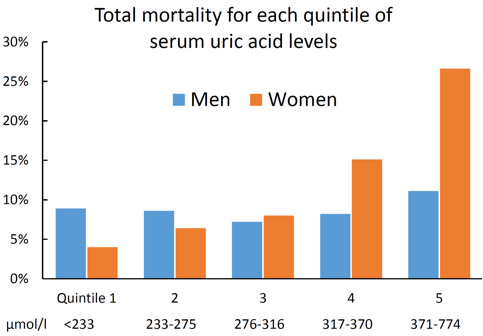Session Information
Session Type: ACR Poster Session A
Session Time: 9:00AM-11:00AM
Hyperuricemia induces chronic inflammation and is associated with many diseases such
as metabolic syndrome, high blood pressure, chronic kidney disease and cardiovascular
diseases. The best known manifestation is gout. Risk for gout flares begins
when serum uric acid exceeds 360mmol/l. That is also internationally used as the limit for hyperuricemia.
Because hyperuricemia
is connected with many severe health problems, we investigated whether serum uric
acid levels associate with survival in a population-based cohort.
Methods:
The data is based on health study with representative
nationwide population sample of adults from a Western society. Information about
health and living habits was collected by questionnaires and interviews.
Everyone went through a physical examination, and a large range of laboratory
tests. The mortality analyses were performed separately for men and women. Unadjusted
mortality was calculated for each quintile of uric acid levels. Adjusted prognostic
capacity of serum uric acid levels was analyzed with Cox regression with the
following covariates: age, body mass index (BMI), diagnoses of coronary artery
disease, hypertension and diabetes; fasting serum levels of LDL cholesterol and
triglycerides and serum gamma-glutamyl transferase. The end-points were all-cause and
cardiovascular mortality, separately.
Results:
The dataset consisted of 6691 subjects (3703
or 55.3% were women) aged 30 years or more. Mean age was 54 years with
interquartile range (IQR) 51–65 years. Mean BMI was 26.9 (IQR 23.6–29.5).
At the baseline, mean uric acid level was 303 mmol/l (IQR 243–353mmol/l). The prevalence of hyperuricemia was 1529 (22.9%), being essentially higher
than the prevalence of diagnosed gout with 64 participants (1.0%). During the median
follow-up of 72 (IQR 70–73) months, the total number of deaths was 607
and number of cardiovascular deaths was 262.
Unadjusted mortality increased
systematically along the elevating uric acid level quintile for women but not
for men (Figure). Hyperuricemic women had an adjusted
hazard ratio (HR) 1.41 (p=0.010) for mortality in comparison to those without hyperuricemia; for men 0.94 (p=0.650). Similarly, HR for
cardiovascular mortality was 1.87 (p=0.002) for women and 1.18 (p=0.408) for
men
Conclusion:
Our study shows that elevating serum uric
acid levels have significant association with the risk of total and
cardiovascular mortality among women. Remarkably, the increase in mortality took
place even before the commonly used level of hyperuricemia
was reached. This interesting finding confirms results from earlier studies: uric
acid level and at least hyperuricemia is a reason for
concern even before flares of gout.
To cite this abstract in AMA style:
Kauppi JE, Nieminen T, Kähönen M, Kerola A, Jula A, Leiviskä J, Kauppi MJ. Uric Acid Levels Predict Mortality in Women [abstract]. Arthritis Rheumatol. 2015; 67 (suppl 10). https://acrabstracts.org/abstract/uric-acid-levels-predict-mortality-in-women/. Accessed .« Back to 2015 ACR/ARHP Annual Meeting
ACR Meeting Abstracts - https://acrabstracts.org/abstract/uric-acid-levels-predict-mortality-in-women/

